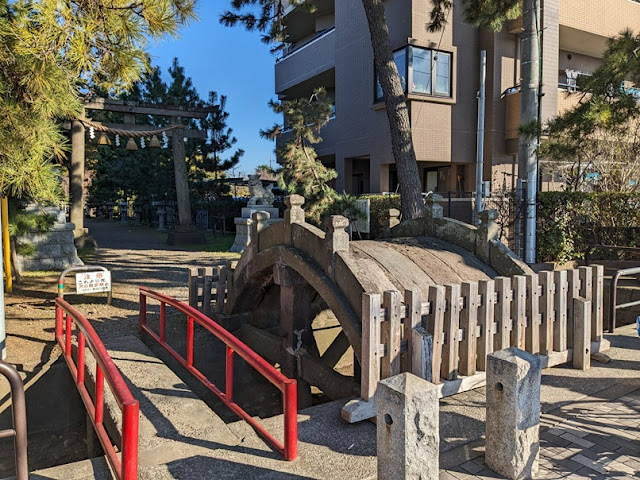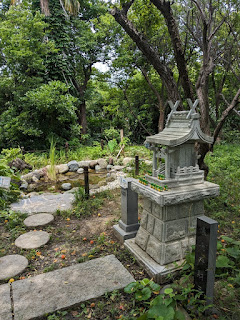Tsurumine Hachimangū (鶴嶺八幡宮)
 |
| Tsurumine Hachimangu during the Yayoi-sai |
The sign in front of the shrine building explains that Tsurumine Hachimangu traces its origins to the Kohei era (1058–1065) when Minamoto no Yoriyoshi (998–1075) founded a shrine, modelled after Iwashimizu Hachimangu, in Yabata Village (mainly the Yabata District of Chigasaki today) during a military campaign. However, according to Tsurumine Hachimangu's official website, the shrine dates back to 1030 when Yoriyoshi arrived in the area on his way to suppress an uprising and enshrined the kami of Iwashimizu Hachimangu (some sources suggest Usa Hachimangu), the guardian deity of the Minamoto clan. In addition, a sign placed at Tsurumine Hachimangu's kenmu-sha (jointly administered shrine), Honshagu, states that in 1089, Minamoto no Yoshiie (1039–1106) cleared a vast area of land in Hamanogo Village (mainly the Hamanogo district of Chigasaki today) and built Tsurumine Hachimangu.
During the Eiroku (1558–1570) and Genki (1570–1573) eras, the shrine was damaged by fires during battles of the time, resulting in the destruction of the shrine building and old records.
 |
| Sazukari-ishi (left), Megogaishi (center), and monuments honoring Chokei |
 |
| Dosojin |
According to a sign placed, along the sando (pathway), between Megogaishi (女護ヶ石) — a sacred stone believed to be a guardian deity for women — and the Dosojin (道祖神) — kami commonly worshipped in the Kanto region as tutelary deities of borders and paths, believed to protect travelers, pilgrims, and villages — in 1649, Tokugawa Iemitsu (1604-1651), the third shogun of the Edo shogunate, donated 7 koku of land in the Honson district to the shrine. In commemoration of this donation, Chokei (朝恵), a high-class Buddhist monk of the betto-ji (a Buddhist temple that managed a Shinto shrine until the Edo period) of Joko-in (常光院), which used to stand west of the shrine, with the cooperation of the local lord, Yamaoka Kagenobu (山岡景信), reconstructed the shrine building and planted pine trees along the sando and the riding ground in front of the shrine. However, the sign in front of the shrine building states that the reconstruction of the shrine building and planting of the pine trees were conducted during the Shoho era (1644–1648), before the land donation in 1649.
 |
| Sando of Tsurumine Hachimangu |
The sando is designated as a historical site and the pine trees as natural monuments by Chigasaki. Today, the sando between the first and second torii (shrine gate) functions as a roadway.
 |
| First torii of Tsurumine Hachimangu |
There is a stone bridge called Taiko-bashi (太鼓橋) in front of the second torii.
 |
| Second torii (back left) and Taiko-bashi (right) |
Tsurumine Hachimangu's shrine office is normally open from 8:00 AM to 3:00 PM on weekdays and from 8:00 AM to 4:00 PM on weekends and holidays.
 |
| Some of Tsurumine Hachimangu's goshuin (seal stamps issued by Buddhist temples and Shrine shrines as a token of pilgrimage or visit) from 2002 |
The Ginkgo Tree of Tsurumine Hachiman (鶴嶺八幡のイチョウ)
The ginkgo tree standing in front of the shrine building is Kanagawa Prefecture's largest and is reputedly planted by Minamoto no Yoshiie. Recognized as a natural monument by Kanagawa Prefecture in 1962, it was also selected as one of "Kanagawa's Top 100 Famous Trees" in 1984.
Goshinboku (御神木)
 |
| Goshinboku |
The goshinboku (a sacred tree at a Shinto shrine believed to be a dwelling place of kami) is believed to have been planted around the time the shrine was founded. It has been known as a "rising dragon" since it looks like a dragon facing up. The sign explains that a white snake, considered a messenger of the goddess Benzaiten, is occasionally spotted coiling around the tree. It is said offering eggs on snake day (巳の日) each month can bring prosperity.
Meoto-Kusu (夫婦楠)
 |
| Meoto-Kusu |
In front of the torii at the subordinate shrine of Tsurumine Inari Jinja (鶴嶺稲荷神社), there is a pair of trees known as Meoto-Kusu (夫婦楠), which literally translates to "husband and wife camphor trees." It is said that passing between the two camphor trees toward Tsurumine Hachimangu brings good fortune in finding a suitable partner or improves relationships between lovers or married couples.
Michibiki no Ki (みちびきの木)
 |
| Michibiki no Ki |
Behind the honden (main hall) of Tsurumine Hachimangu stands a tree called Michibiki no Ki (みちびきの木), which literally translates to "guiding tree." The sign in front of the tree reads: "Whisper your worries and anxieties softly, for I will heal you and guide you in a better direction."
Warako (わらこ), the Zashiki-Warashi
 |
| The area Warako is said to be playing around |
One of the well-known spirits in Japanese folklore is the zashiki-warashi which is said to be in the form of a child wearing traditional Japanese clothes. Despite being rarely seen directly, encounters are often marked by footsteps, the sound of children's voices at midnight, footprints in ashes, or handprints on walls. It is believed to bring good luck, particularly to the homes they inhabit. While most reports of zashiki-warashi come from the Tohoku region, especially Iwate Prefecture, a female zashiki-warashi named Warako (わらこ) is said to reside in Tsurumine Hachimangu.
Subordinate Shrines
Hokonomiya Jinja (鉾宮神社)
 |
| Hokonomiya Jinja during the Yayoi-sai |
Not much is known about Hokonomiya Jinja (鉾宮神社) due to the lack of detailed records. It was recorded as a non-ranked shrine as of June 21, 1889. According to the sign in front of the torii, the shrine enshrines the kami Susanoo-no-Mikoto (須佐之男命) and Kotohira-no-Mikoto (古刀比羅命). Additionally, Tsurumine Hachimangu's official website mentions that it also enshrines the kami Hokonomiya-no-Okami (鉾宮大神).
Shonan Awashima Jinja (湘南淡嶋神社)
 |
| Harizuka (left), Shonan Awashima Jinja (center), and Ganfuji-ishi (right) |
 |
| Tofu used for hari-kuyo |
Shonan Awashima Jinja (湘南淡嶋神社) enshrines the kami Sukunahikona no Mikoto (少彦名命) and Awashima no Kami (淡嶋神).
Beside the shrine, a stone monument engraved with "針塚" (Harizuka), meaning "needle mound," is used for hari-kuyo ceremonies held on February 8 and December 8.
On the right side of the shrine stands Ganfuji-ishi (癌封じ石), the "cancer-blocking stone," believed to heal cancer and other illnesses. After visiting the haiden (worship hall) of both Tsurumine Hachimangu and Shonan Awashima Jinja, chant "祓え給へ、清め給へ (Harae tamae, kiyome tamae)" three times while rubbing the stone and the affected part of your body.
Tsurumine Inari Jinja (鶴嶺稲荷神社)
 |
| Tsurumine Inari Jinja |
Tsurumine Inari Jinja (鶴嶺稲荷神社) enshrines the kami Ukanomitama-no-Okami (宇迦之御魂大神).
Amaterasu Kotaijingu (天照皇大神宮)
 |
| Amaterasu Kotaijingu |
Amaterasu Kotaijingu (天照皇大神宮) enshrines the kami Amaterasu Omikami (天照大神).
Futokorojima Benzaiten (懐嶋弁財天)
 |
| Futokorojima Benzaiten |
Futokorojima Benzaiten (懐嶋弁財天) enshrines the kami Ichikishimahime-no-Mikoto (市杵島姫命). Benzaiten, originally an Indian goddess Saraswati, was identified with Ichikishimahime-no-Mikoto during the days of shinbutsu-shugo (the syncretism of Shinto and Buddhism).
The paved sando of Futokorojima Benzaiten has bird footprints. There is also a small pond with Japanese rice fish on the left side of the shrine.
Reference:
- Tsurumine Hachimangu. (n.d.). 湘南茅ヶ崎鎮守. 鶴嶺八幡宮 Tsurumine Hachimangu. https://www.tsuruminehachimangu.com






Comments
Post a Comment